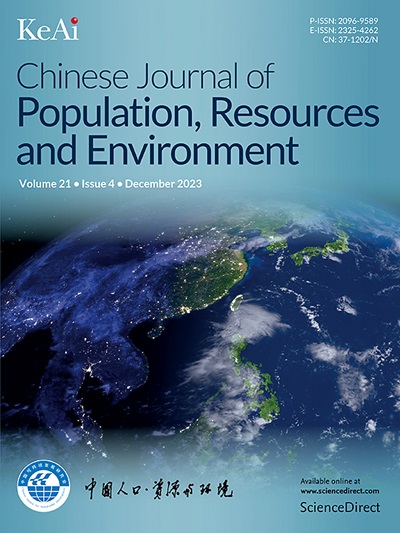Harnessing groundwater resources in hard-rock terrain: A geoinformatics perspective of the Bandu Sub-watershed of Purulia District, India
IF 4.8
4区 环境科学与生态学
Q2 ENVIRONMENTAL STUDIES
Chinese Journal of Population Resources and Environment
Pub Date : 2025-09-01
DOI:10.1016/j.cjpre.2025.07.011
引用次数: 0
Abstract
Groundwater, the world’s largest freshwater supply, is facing increasing strain due to various uses such as agriculture, industry, livestock, and household. This study aims to investigate groundwater prospective zonation in the Bandu Sub-watershed in Purulia, West Bengal, using the AHP model and RS & GIS methodologies. To achieve Goal 6 of the UN-initiated 17 SDGs, it is crucial to determine the spatial distribution of groundwater prospective zones village-by-village, with 1/3 of the regions falling under red alert zones for sustainable development. The 16 most crucial elements affecting groundwater prospective zones (GWPZs) were mapped using AHP, and the final prospective map was obtained through Weighted Overlay analysis. The study identified five different classes within the Sub-watershed as excellent, good, moderate, poor, and very poor. The validation results showed that the approach used to derive GWPZ is reliable, and the results can be applied to future sustainable developments to reduce water shortages through suitable management methods. The research aims to increase the effectiveness of sustainable groundwater zone management, ensuring long-term water management and access.
在硬岩地形中利用地下水资源:印度普鲁里亚地区班杜小流域的地理信息学视角
地下水是世界上最大的淡水资源,由于农业、工业、牲畜和家庭的各种用途,它正面临越来越大的压力。本研究旨在利用AHP模型和RS & GIS方法,调查西孟加拉邦普鲁里亚邦班杜流域的地下水远景分区。为了实现联合国发起的17项可持续发展目标中的目标6,确定逐村地下水远景区的空间分布至关重要,目前有1/3的地区处于可持续发展红色预警区。采用层次分析法对影响地下水远景区的16个最关键要素进行制图,并通过加权叠加分析得到最终的远景图。该研究将子流域划分为优秀、良好、中等、较差和极差五个等级。验证结果表明,该方法推导出的GWPZ是可靠的,可以通过适当的管理方法应用于未来的可持续发展,以减少水资源短缺。本研究旨在提高可持续地表带管理的有效性,确保长期的水资源管理和获取。
本文章由计算机程序翻译,如有差异,请以英文原文为准。
求助全文
约1分钟内获得全文
求助全文
来源期刊

Chinese Journal of Population Resources and Environment
ENVIRONMENTAL STUDIES-
CiteScore
4.30
自引率
1.10%
发文量
791
审稿时长
79 days
期刊介绍:
The Chinese Journal of Population, Resources and Environment (CJPRE) is a peer-reviewed international academic journal that publishes original research in the fields of economic, population, resource, and environment studies as they relate to sustainable development. The journal aims to address and evaluate theoretical frameworks, capability building initiatives, strategic goals, ethical values, empirical research, methodologies, and techniques in the field. CJPRE began publication in 1992 and is sponsored by the Chinese Society for Sustainable Development (CSSD), the Research Center for Sustainable Development of Shandong Province, the Administrative Center for China's Agenda 21 (ACCA21), and Shandong Normal University. The Chinese title of the journal was inscribed by the former Chinese leader, Mr. Deng Xiaoping. Initially focused on China's advances in sustainable development, CJPRE now also highlights global developments from both developed and developing countries.
 求助内容:
求助内容: 应助结果提醒方式:
应助结果提醒方式:


